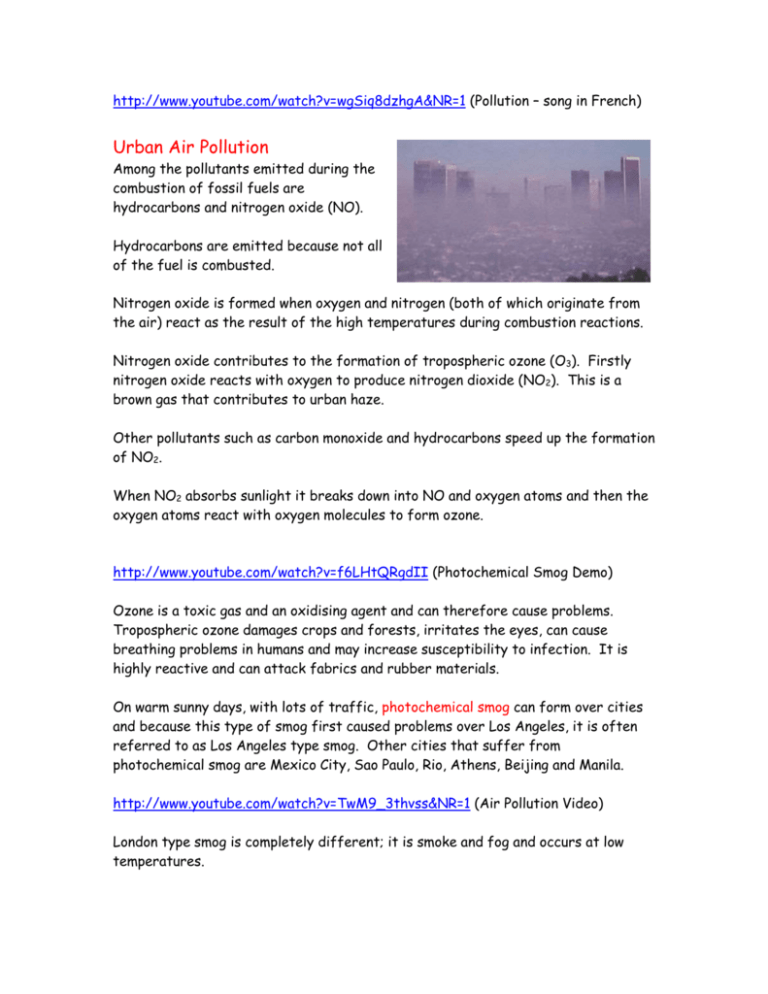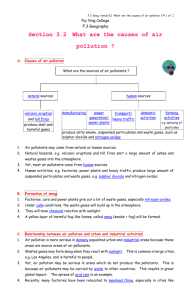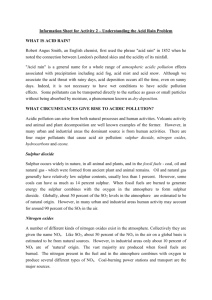Urban Air Pollution & Acid Deposition
advertisement

http://www.youtube.com/watch?v=wgSiq8dzhgA&NR=1 (Pollution – song in French) Urban Air Pollution Among the pollutants emitted during the combustion of fossil fuels are hydrocarbons and nitrogen oxide (NO). Hydrocarbons are emitted because not all of the fuel is combusted. Nitrogen oxide is formed when oxygen and nitrogen (both of which originate from the air) react as the result of the high temperatures during combustion reactions. Nitrogen oxide contributes to the formation of tropospheric ozone (O3). Firstly nitrogen oxide reacts with oxygen to produce nitrogen dioxide (NO2). This is a brown gas that contributes to urban haze. Other pollutants such as carbon monoxide and hydrocarbons speed up the formation of NO2. When NO2 absorbs sunlight it breaks down into NO and oxygen atoms and then the oxygen atoms react with oxygen molecules to form ozone. http://www.youtube.com/watch?v=f6LHtQRgdII (Photochemical Smog Demo) Ozone is a toxic gas and an oxidising agent and can therefore cause problems. Tropospheric ozone damages crops and forests, irritates the eyes, can cause breathing problems in humans and may increase susceptibility to infection. It is highly reactive and can attack fabrics and rubber materials. On warm sunny days, with lots of traffic, photochemical smog can form over cities and because this type of smog first caused problems over Los Angeles, it is often referred to as Los Angeles type smog. Other cities that suffer from photochemical smog are Mexico City, Sao Paulo, Rio, Athens, Beijing and Manila. http://www.youtube.com/watch?v=TwM9_3thvss&NR=1 (Air Pollution Video) London type smog is completely different; it is smoke and fog and occurs at low temperatures. The main primary pollutants are also different: SO2 and smoke particles that are produced from burning coal. These smogs killed many people until clean air acts legislated to stop people burning coal and use smokeless fuel instead. (http://www.authorstream.com/Presentation/aSGuest7665-126648-air-pollutionothers-misc-ppt-powerpoint/) website for PowerPoint Acid Deposition Acids are chemicals that have the ability to donate hydrogen ions (H+) to other chemicals. The acidity of solutions is measured using the pH scale which ranges from 0 to 14. A pH value of 7 is neutral (pure water); values below 7 indicate acidic solutions and values above 7 indicate basic (alkaline) solutions. The pH scale is not linear. For example, a solution with a pH of 2 is ten times more acidic than a solution with a pH of 3 and 100 times more acidic than a solution with a pH of 4. Rainwater is naturally acidic because it dissolves CO2(g) that is in the atmosphere producing carbonic acid (H2CO3) as it falls. The pH level of this rainwater has fallen over recent years from around pH6 to somewhere around pH3.5 and in some areas as low as pH2. This increase in acidity has caused damage to the environment especially crops, forests, lakes and marine life and this is due to increased amounts of gases such as SO2 being emitted into the atmosphere. Main Pollutants and their Sources Air pollutants can be divided into primary and secondary air pollutants. Primary pollutants are those that are emitted directly – pollutants leaving the chimney of a factory or the exhaust of a car for example. Primary pollutants can change to secondary pollutants by reacting with other substances in the atmosphere. Therefore secondary pollutants are made after the primary pollutants leave the car exhaust for example. As stated earlier, the primary pollutants that cause acid deposition are the SOx and NOx. These are the sulphur oxides and the nitrogen oxides and the most important human activity that leads to the release of these pollutants is the combustion of fossil fuels in motor vehicles, industry and electricity production. Sulphur dioxide (SO2) is formed when sulphur containing fuels are burnt. Sulphur is common in coal and oil but is not usually present in natural gas. Nitrogen oxides are formed by the reaction of nitrogen and oxygen from the air which takes place readily at the high temperature used to burn fossil fuels – the nitrogen is not part of the fuel. If primary pollutants are in the atmosphere for a long enough time, a variety of secondary air pollutants can form. SO2 can react with oxygen in the atmosphere and form sulphur trioxide (SO3). Both SO2 and SO3 can react with water vapour in the atmosphere to produce sulphurous acid and sulphuric acid (H2SO3 and H2SO4 respectively). The nitrogen oxides can also react with water vapour producing nitric acid. These secondary pollutants are very soluble in water and are removed from the air by precipitation in the form of rain, snow and hail (wet deposition). Carbon monoxide forms when petrol or diesel is ignited in a car engine and there is not enough oxygen reaching the fuel to burn it completely. The CO is then released into the atmosphere through the cars exhaust. The amount of CO released can be reduced using a Catalytic Converter. Catalytic Converters These can be added to exhaust systems to speed up the reactions involved in turning pollutant gases into less harmful products. They can only be used with unleaded petrol. These pollutant gases are present in the gaseous mixture produced following the combustion of the petrol in the engine of the vehicle. Carbon monoxide is produced by the incomplete combustion of the fuel. This occurs when there is insufficient air mixed with the fuel. 2C8H18(g) + 17O2(g) → 16CO(g) + 18H2O(g) Nitrogen oxide (monoxide or nitric oxide) forms at very high temperatures inside the engine (≈1000oC). This high temperature provides enough energy for nitrogen and oxygen molecules to bond and form the NO. This is oxidised when it mixes with air. 2NO(g) + O2(g) 2NO2(g) → NO2 is a brown gas and NO is colourless and the catalytic converter helps to promote the following: The oxidation of carbon monoxide to carbon dioxide. 2CO(g) + O2(g) 2CO2(g) → The reduction of NO back to nitrogen. 2NO(g) + 2CO(g) → N2(g) + 2CO2(g) The oxidation of hydrocarbons to water and oxygen. 2C6H6(g) + 15O2(g) → 12CO2(g) + 6H2O(l) These converters cannot, however, solve another problem – the Greenhouse Effect and Global Warming. The extra CO2(g) going into the atmosphere is disturbing the natural balance of this gas and helping cause the Earth to get warmer. Radiation at Different Wavelengths. The solar radiation that comes through the Earth’s atmosphere has a short wavelength and is therefore of a high energy. When some of this energy is absorbed by the Earth the reflected radiation, that is heading out into space, has less energy and therefore has a longer wavelength. This lower energy radiation is absorbed by the various ‘greenhouse gases’ and re-radiated back towards the Earth’s surface causing a rise in temperature. i.e. shortwave uv and visible light passes through the atmosphere warming the Earth but longer wave infra red radiation is trapped after being emitted from the surface. Particulates in the Atmosphere Particulates also have an influence on the Earth’s surface temperature by reflecting sunlight. Particulates are usually big enough to be seen by the naked eye and are usually solids or liquids suspended in the air. Particulates are often called aerosols. Pollution Management Strategies for Acid Deposition The following table uses the “replace, regulate and restore” model of pollution management strategy to list some actions for reducing acid deposition and their evaluations. Timeline for Political Solutions Evaluation of Success An average of 50% reductions was achieved in Europe by 2000. However, LEDC’s are industrialising rapidly and emissions are set to rise rapidly unless MEDC’s can help the LEDC’s to ‘jump’ to the clean technologies and ecocentric lifestyles. Liming Lakes to Neutralise Acidity Starting in the 1950’s, the loss of many fish and invertebrate species in a large number of Scandinavian lakes was linked to high levels of lake acidity and by 1990 nearly 400 lakes were virtually lifeless. In the 1980’s Sweden experimented with adding powdered limestone (calcium carbonate (CaCO3)) to their lakes and rivers – the results were mixed. The pH of the treated lakes was raised quickly but short lived because of the flow of water – liming only treats the symptoms and not the cause. Biodiversity was not immediately restored as the lime seemed to affect the nutrient balance as nutrients other than calcium were absent. Reducing Emissions One way to reduce the emission of nitrogen oxides and sulphur dioxide is to reduce the combustion of fossil fuels. Reducing the need for electricity, the use of motor vehicles, developing more efficient cars and switching to alternative energy sources such as water, wind and solar energy can do this. Bio-fuels and nuclear power will also reduce the amount of SO2 and NOx being produced. Precombustion techniques aim to remove the sulphur from the fuel before combustion therefore reducing SO2 emissions. The sulphur that is removed can be obtained in different forms: As elemental sulphur which can be used in the chemical industry; as gypsum which can be used in construction or as sulphur dioxide, which is used in the production of sulphuric acid (H2SO4) – one of the most widely used chemicals. Acidification can be reduced by using “end of pipe” measures. These clean up measures remove the SO2 and NOx from the waste gases using such things as waste gas scrubbers in power plants and catalytic converters in motor vehicles. Waste gas scrubbers are intended to remove SO2 and catalytic converters in motor vehicles remove NOx along with other pollutants. The catalyst in the converter is destroyed by SO2 so cars fitted with them use sulphur free fuels. End of pipe is also referred to as ‘point of emission’.








